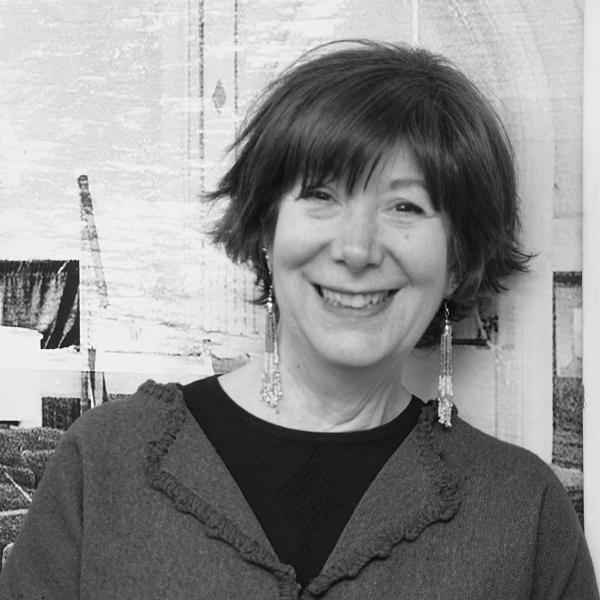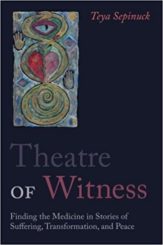A conversation with Teya Sepinuck, founder and artistic director of Theater of Witness
Theater of Witness is a form of testimonial performance and documentary films performed by people sharing their personal and collective stories of suffering, transformation, and peace. Developed more than 30 years ago by Artistic Director Teya Sepinuck, the work brings people together across divides of difference to bear witness to each other’s life experiences. Performers who have survived trauma, marginalization, oppression, and the complexity of the human experience address some of society’s most challenging issues from a multiplicity of perspectives.
The performances weave the performers’ stories together with music, spoken word, visual imagery, and film into dynamic theater that humanizes the “other” and cultivates compassion and empathy. The result is authentic, raw, and powerful theater that celebrates the resilience of the human spirit.
What can you tell me about the capacity and power of theater to nurture peace in a violent world?
 One of the most important things Theater of Witness does is to help people humanize each other—to see people who are really different from themselves and be able to say, “If I had had those experiences, that might be how I dealt with things,” or “I would probably feel like that if I were in their shoes.” And I want the pieces to reflect those differences for an audience.
One of the most important things Theater of Witness does is to help people humanize each other—to see people who are really different from themselves and be able to say, “If I had had those experiences, that might be how I dealt with things,” or “I would probably feel like that if I were in their shoes.” And I want the pieces to reflect those differences for an audience.
We are so used to people having all kinds of opinions that separate us into camps, but it’s very difficult to have meaningful dialogue with somebody who believes differently than we do. I’ve found that it’s really only when our hearts are touched that we can dissolve whatever has been frozen in our minds as a belief and we can look with new eyes. That is where peacemaking really happens. When we are vulnerable and we see other people being vulnerable and sharing their true stories, something opens up in our hearts.
…it’s very difficult to have meaningful dialogue with somebody who believes differently than we do. I’ve found that it’s really only when our hearts are touched that we can dissolve whatever has been frozen in our minds.
In 2005 I started working on a piece called “Beyond the Walls” that brought together mothers whose children had been murdered with mothers whose children had committed murder, as well as former prisoners. It was sparked by the death of a 9-year-old boy named Faheem Childs who was caught in the crossfire of a gang war. It galvanized the city of Philadelphia in a new way and I had to do something. The Victim Advocate of Pennsylvania said, “You can’t bring victims together with former prisoners,” and I remember thinking, “Well, you’re wrong.”
It took me a while to get the right people together, but when I met Victoria Greene, whose son had been killed, she told the story of his death and being in the courtroom when the jury pronounced the man who killed her son guilty and sentenced him to life in prison. She said the convicted man’s mother screamed, and “It was the same scream that had come out of me when my son Emir had died.” Then I knew I could do this piece, and I built it around Victoria and one of her daughters.
I saw continual miracles throughout that work. Hakim had spent 40 years in prison. At one of our first meetings for “Beyond the Walls,” he shared that one time he’d had his hands around someone’s neck who pleaded for their life, but he didn’t stop. He admitted the horror of his crime, and said, “I know it makes me seem like a monster; I’m not a monster.” He told that story in front of the mothers, and we were all in tears, and Altovise, whose brother Emir had been killed, stood up and asked if she could hug Hakim. She said, “Thank you for saying what the man who murdered my brother could never say.” And at that moment I knew that we were going to be OK. Throughout the whole process, continually, they just grew in love for each other.
Walk in my Shoes – Hakim’s part (H.264) from Teya Sepinuck on Vimeo.
We performed that piece for two years, at all kinds of venues, and somewhere into the second year, I remember Reuben, who talked in his part about tying up an elderly man and leaving him in a pool of blood, told his story on stage and you could feel that he suddenly heard his story in a new way. He came off stage and just hung onto me and sobbed and sobbed. And then the mothers surrounded him, held him and rocked him and prayed with him. It was the biggest healing, and I remember thinking, “This is the only way for it to heal, when somebody who shouldn’t forgive you forgives you. This is peacemaking. This is healing.” And I think the audience saw the tremendous connections that the group had with each other and that’s what moved them.
Because of that work I was invited to Northern Ireland, where ex-combatants were getting together with victims, but it was very very private, happening behind closed doors on retreats—nobody was talking about it. And the question was: Were people ready to tell their stories publicly at this point? The Historical Enquiries Team was still investigating, and people could still be charged for crimes if they confessed.
I was there for five years and made four pieces. The first one, “We Carried Your Secrets,” was with people whose fathers had been on the front lines and who were young adults: one whose father had been assassinated by the police and loyalist paramilitaries in collusion; one whose father had been in the police; and one young man who was among the antisocial teenagers coming out of the Troubles—his mother wasn’t functioning highly, his father had left and he was on the street and drinking and didn’t care about anybody. And then I had three fathers. Robin had been on the body recovery team as a police officer at one of the worst atrocities; he’d literally picked up human remains, including a heart. John had been in the IRA and he had believed strongly—and still believes—that he was fighting for freedom for Irish nationalists and Catholics—he’d been there on Bloody Sunday and seen many of his friends killed. And James had been in a Loyalist paramilitary group where he worked with a partner making bombs; one day a bomb went off and blew off his partner’s arm, and James spent 14 years in prison. He had never told his children that he had been in a paramilitary group.
So many secrets. We took the title of the piece from the younger performers, who said to their elders, “We’ve been carrying your secrets since the day we were born.” Even when they didn’t know what the secrets were. It took a lot of behind the scenes before I could even get the group together. Fionnbharr, whose father had been assassinated, couldn’t look at Robin the first few meetings—when he saw Robin’s police uniform he just kept his head down and shook. He ended up sharing a room with James, who was in the loyalist paramilitary that probably killed his father. It was at that level. But as they shared their stories in a really safe way, they began to get this intense sense of that could’ve been me… if I had grown up that way and that had been my family and that is what I had gone through, etc, I would have believed the same things. They got very, very close.
When we performed the first night, there was a standing ovation. People were stunned. I remember one man said, “This was open heart surgery on the city of Derry.” It brought out people stories; they cascaded out. Some people saw it many times; they said their eyes were opened in new ways. Another man said it was the first time he’d been able to feel empathy for anyone in the UDA—the group that had burned his house down. It was just amazing.
One of the stories in the piece tells how the IRA kidnapped a Catholic man named Patsy Gillespie who, because he worked on the army base cafeteria, was considered a traitor. They chained him to a van loaded with explosives and make him drive to an army checkpoint, where they detonated it. Five soldiers along with Patsy were completely eviscerated—there was nothing left inside the van after the bomb went off. We knew Patsy’s widow would hear of this story being told, so we invited her to “We Carried Your Secrets.” After she saw it, she came up to me and said, “I have two questions: Will you introduce me to Robin? I want to know if he knows what’s in Patsy’s coffin, because they never knew what body parts belonged to whom, and I don’t feel Patsy’s really in his grave. And can I be in next year’s show?”
I was overwhelmed. So I made that next piece with all women. I knew that I needed somebody who’d been in the IRA. It was very hard to find a woman who would talk about having been in the IRA, but then I met Anne, who had been a quartermaster, which means she’d moved guns and explosives throughout the country. After working on the production she was able to say, “I never thought I killed anyone, but I was a part of this war. What I did makes me directly responsible for the deaths of people, and I have to learn to forgive myself.”
“I never thought I killed anyone, but I was a part of this war. What I did makes me directly responsible for the deaths of people, and I have to learn to forgive myself.”
It was similar to what happened between Hakim and Altovise. Anne told her story and Kathleen was able to listen to it without running out of the room, as she’d done in her first meetings with other ex-combatants. Anne and Kathleen later became extraordinary friends. In the play Kathleen talks about how she wanted to write on Patsy’s headstone Murdered by the IRA, but instead she chose these words: Lord, may he be an instrument of thy peace. “I pray he did not die in vain,” she says in the play.
This is peace building of the highest order. Kathleen told her story—all the horrors of what happened to her after Patsy died, how she couldn’t function, and how she eventually realized that the only way through was to start partnering with ex-combatants. She said, “If I want peace in this country—and I can assure you I do—I can’t wait for other people to do it. I have to do it.” She made good come from something that was so poisoned. And that is the goal for me of this work.
Today she and Anne travel in Europe together doing workshops. People think it’s about politicians signing agreements, but this is real peacemaking. It’s their bravery and their willingness to do this work and then to model it that gives audiences a sense of hope. Even though the stories are heartbreaking and painful, people hear truth and they think, “Wow, this is what war does.” Not everybody says they’re sorry for what they did. One of the performers from “We Carried Your Secrets” said he would do it all again, because he believed he was fighting for his country, but he was able to work with the other people and they can listen to each other and they can create deep, meaningful friendships. So that is what peace means to me.
14 Anne-Kathleen from Teya Sepinuck on Vimeo.

 Theatre of Witness: Finding the Medicine in Stories of Suffering, Transformation and Peace chronicles Sepinuck’s three decades of creating and producing theatre with people whose stories have previously gone untold, including prisoners and their families, refugees, immigrants, survivors and perpetrators of domestic abuse, ex-combatants, and teenage runaways.
Theatre of Witness: Finding the Medicine in Stories of Suffering, Transformation and Peace chronicles Sepinuck’s three decades of creating and producing theatre with people whose stories have previously gone untold, including prisoners and their families, refugees, immigrants, survivors and perpetrators of domestic abuse, ex-combatants, and teenage runaways.


